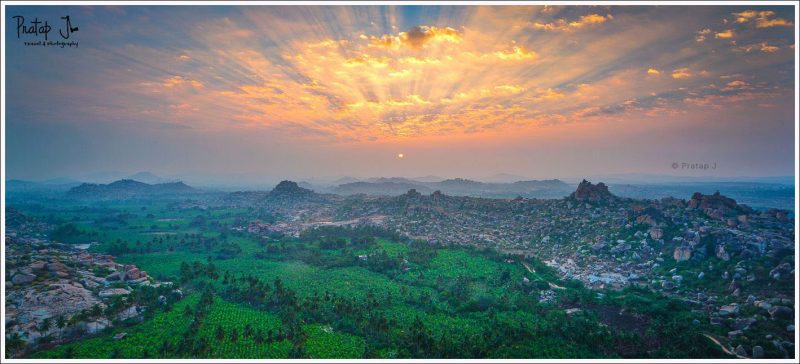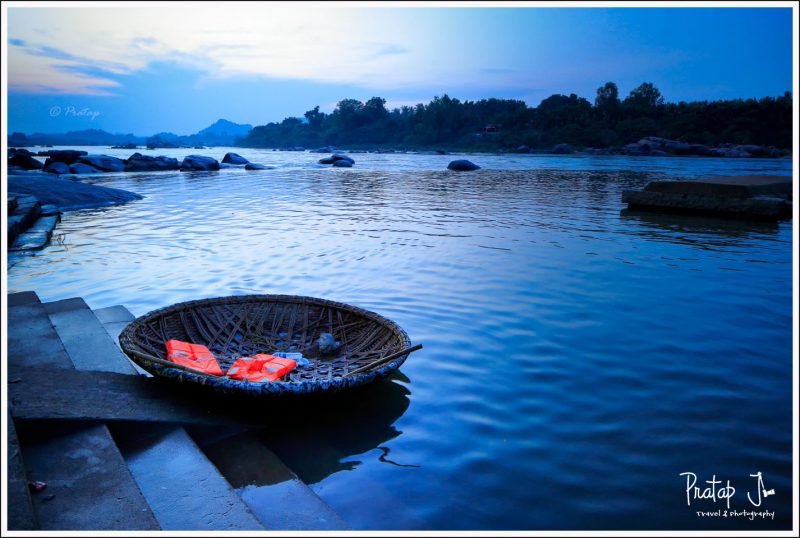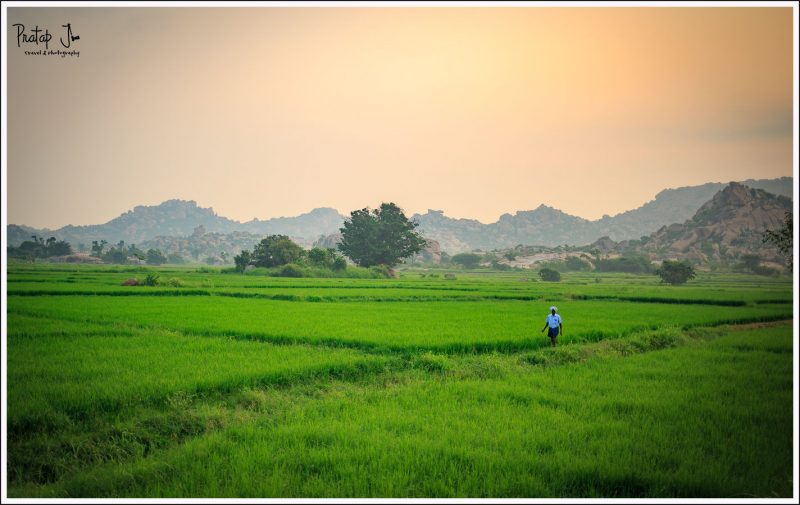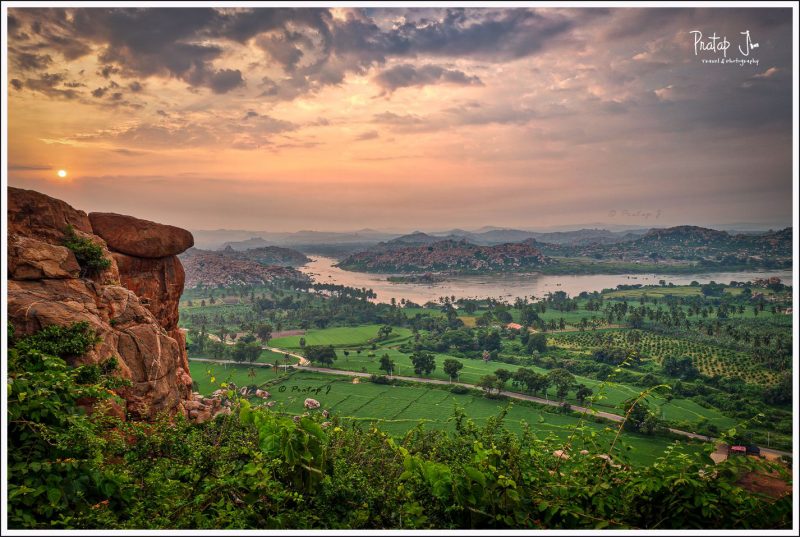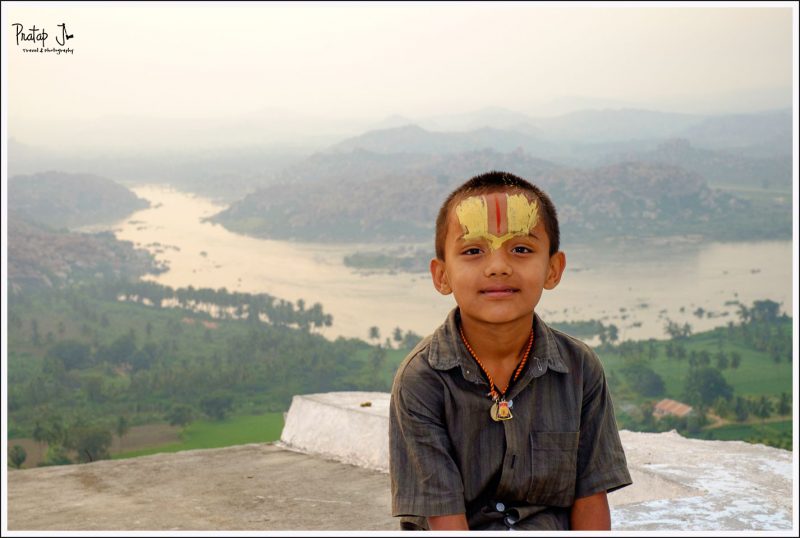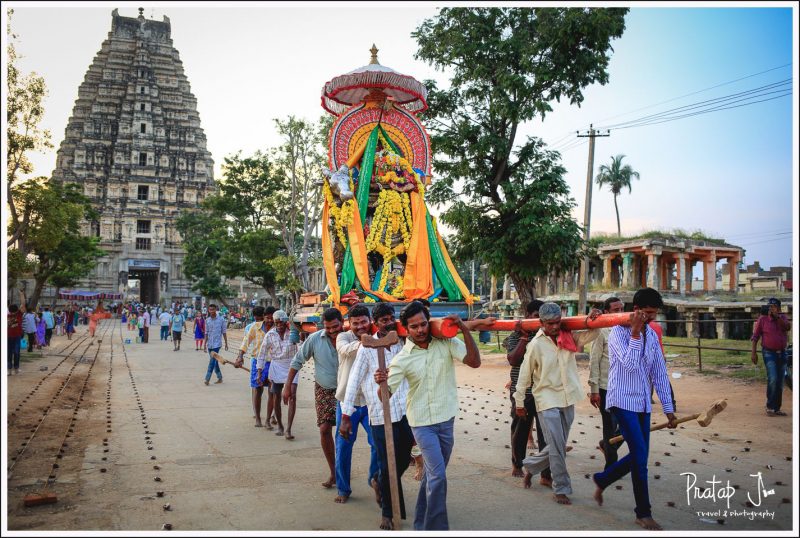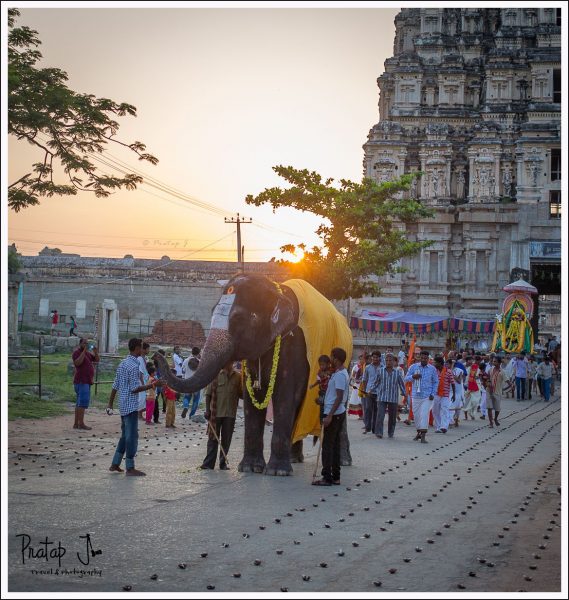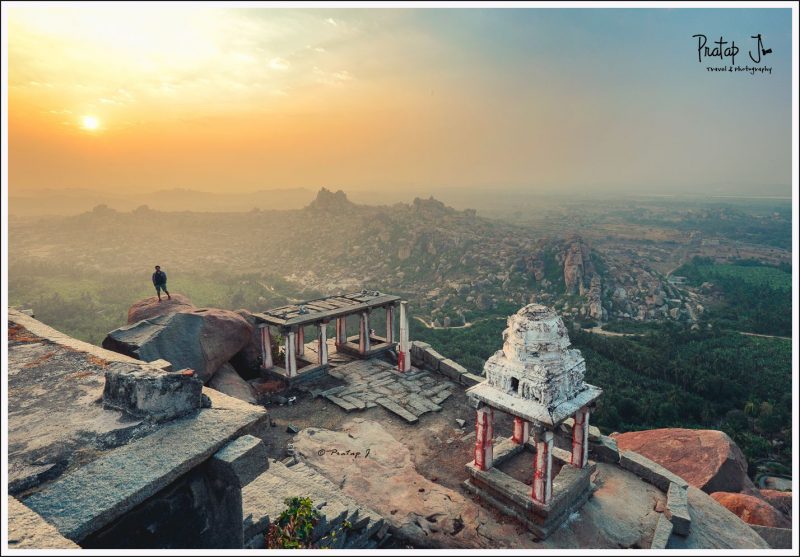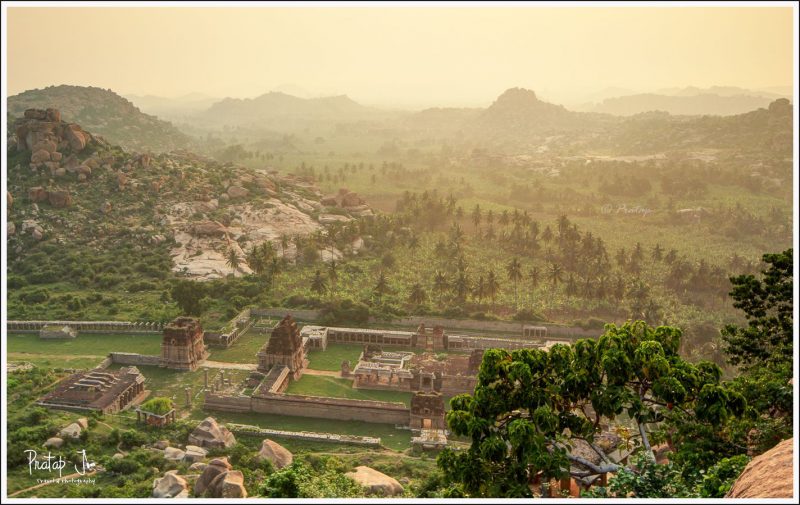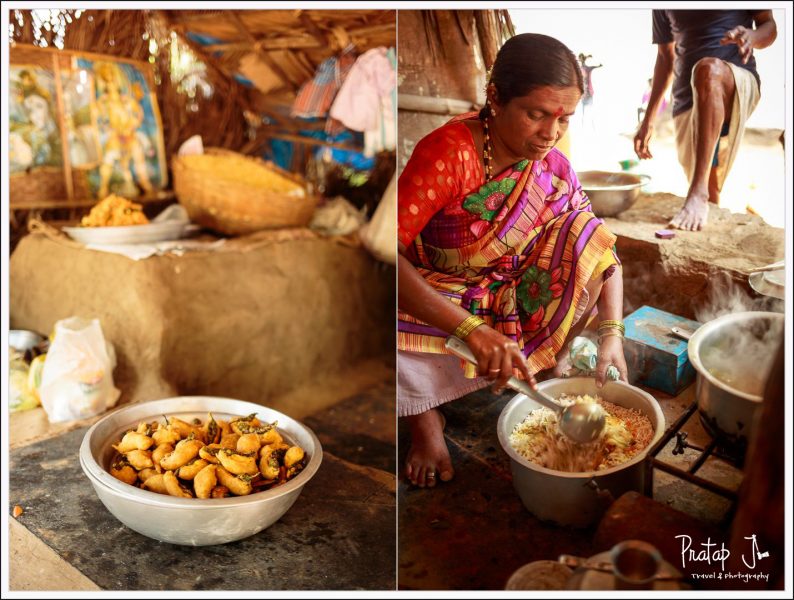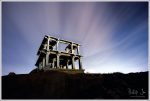Update 1: In September 2016, I updated this article with photos from more recent trips and a few from older trips. The text remains the same as that of the original article which was written in 2014.
Hampi is touted as a popular tourist destination by the government of Karnataka. Being a world heritage center, Hampi is well know not just locally, but also internationally. My third visit to Hampi was in 2014, having been there in 2010 and 2007 previously. Few things had changed, while many sights and scenes still looked the same. My most recent trip was completely dedicated to photography. Read on to know about the places we visited, and the best times to shot photographs in Hampi.
For the photographer, Hampi has many elements of interest. Undulating rocky terrain interspersed with crumbling ruins of a once glorious empire, banana plantations and paddy fields enriched by the Tungabadra river flowing in close proximity, and easily accessible hillocks that provide excellent views of the landscape all make Hampi a great destination. Scores of travelers of all sorts loiter around the Virupaksha temple, while simple villagers turn hardcore salesmen to grab their attention. On a typical long weekend, you will find amateur photographers with DSLRs lingering around the Hampi Bazaar area, and near the ASI protected monuments.
On this particular long weekend of Dussehra, we were three dedicated photographers who were on a mission to capture the magic of Hampi. We had planned everything from choosing locations based on the position of the sun, to acquiring permission from ASI to use tripods within the protected monuments. Everywhere we went, we were greeted with surprised looks because of the gear we were carrying. Our days were measured by the number of photo opportunities. The photographs you see here is a result of this determination.
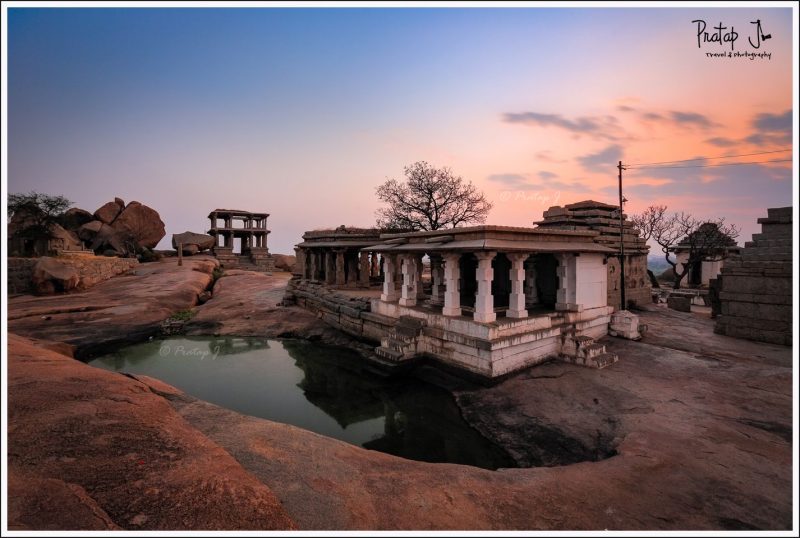
If photography is not your thing, you can still lose yourself in Hampi. Across the river, the cottages at Anegundi are perfect to relax to the rhythm of modest village living. The hillock of Anjanadri is a great way to mesmerize yourself with a birds-eye view of the well-planned Vijayanagar Empire. Anjanadri and Anegundi welcome hippies, wannabes, and devotees alike.
Planning Ahead
Our trip coincided with a four day long weekend, so rooms were unavailable in most popular hotels when I checked three weeks in advance. Sai Plaza, a property where I had stayed previously, came to our rescue. This is a river side guest house offering cheap rooms with clean, basic facilities. I made an advanced reservation on their website directly.
With our stay in Hampi taken care of, the next task was to obtain written permission from the Archaeological Survey of India (ASI) in Bangalore to use a tripod in the vicinity of the protected monuments at Hampi. The fact that you cannot use a tripod without prior permission isn’t mentioned on the ASI website, nor anywhere near the protected monuments. ASI – you need to fix this ASAP. The permission did not come through easily, but it was worth the effort.
The last thing we needed to consider was our time of departure from Bangalore. We planned to leave as early in the morning as possible. The goal was to avoid the rush of cars that hog the highways during long weekends. In spite of hitting the road by 5 am, we spent around 30 minutes at the toll gates, before entering the highway to Tumkur. Our initial plan was to have benne dosa at Dobbaspet, but we missed the exit. Google Maps helped us identify the next best place for breakfast – Sri Lakshmi Bhavan Tiffin Room in Chitradurga. We were wise enough to avoid places like Kamat Upachar, which we knew would crowded with the usual suspects reading up on Team-BHP. The condition of the road after Chitradurga was pathetic, and the heat was oppressive. We reached Hospet by 12.30, spending 7.5 hrs on the road.
Sunset at Hemakuta Hill and Malyavanta
The distance from Hampi to Anajandri where we had our rooms, was 40 km by road. Alternatively, a 50 rupee motor boat ride could get us (and not the car) across the river in 10 minutes. Unfortunately for us, boats were not operating on the day we reached Hampi. The water levels were high after seasonal rains. I found the dependency on forces of nature a tad bit ridiculous. Sometime back the government did try and build a bridge across the river, but it collapsed even before it was completed. Ironically, stone pillars from the bridge built by Krishnadevraya stand even today.
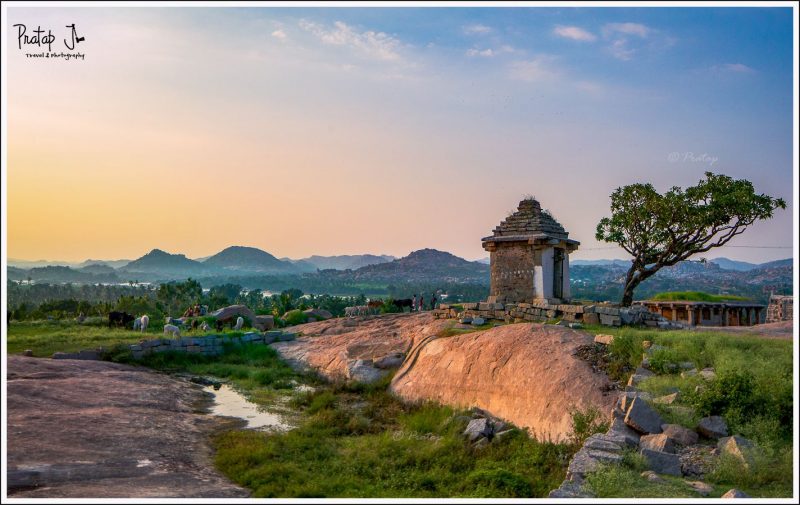
With no boat available to check-in, we decided to spend time in Hampi till sunset, and drive to the guest house later at night. The target was to be at Hemakuta hill by 5.30 pm. The view of the setting sun and the Tungabadra river from Hemakuta is exhilarating. Ruins of an ancient Jain temple and other monuments are scattered around the hill. Since sunset was still a while away, we leisurely had lunch at a restaurant called Mango Tree. This popular place was once beside the river and under a huge Mango tree. Now it is in one of the bylanes of the Hampi Bazaar. Mango Tree is a must-visit for their lassi. There were far more Indians this time, than I recall seeing in 2010.
After lunch, we drove to Malyavanta hill, around 4 km away from the parking lot near Virupaksha. A temple dedicated to Lord Rama is on this hill. Interestingly, we found Hindi speaking Brahmins from MP living here. A few photographers were also hanging around behind the temple. From this place, you have an unobstructed view of the westward landscape. Green fields provide an excellent foreground for photographs. We decided to visit Malyavanta for sunset on another occasion, because this time I wanted to flaunt the letter from ASI that I worked hard to get 🙂
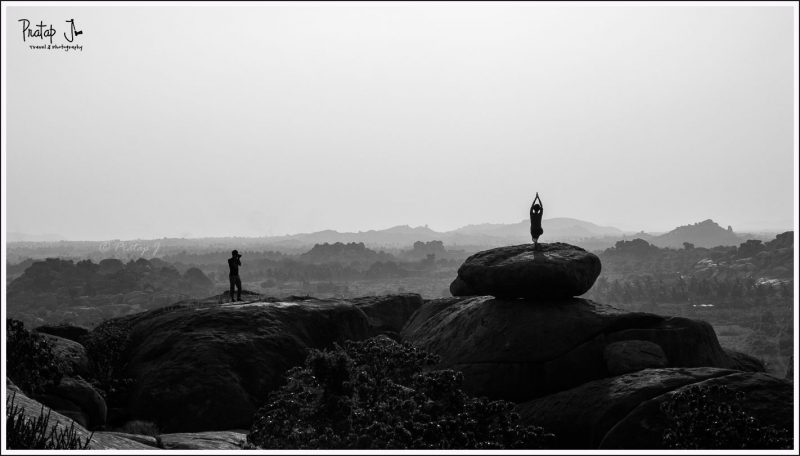
From Malyavanta, we returned to Hemakuta. As we climbed up past the kadalekalu ganesha idol, we noticed that quite a few tourists had already gathered to witness the sun go down. I rushed to most of the shoot, and it turned out to be a memorable evening. I managed to make some nice pictures in spite of the crowds that walked into my frame more than once.
We still had a long way back to comfort. The forty kilometers drive to Anjanadri wasn’t easy. We navigated through narrow State Highway roads. Very few things had changed in the last 7 years. Locals were still taking a dump by the road side after dark. The road conditions were as bad as ever, and villages were still connected by precariously built bridges. In fact, one of the villagers who gave us direction said we may not be able to reach Anjanadri because of a road block But we knew better than to trust a villager on the road after 8 pm. 🙂
Sunrise from Anjanadri Hill
One of the perks of staying in Anegundi is the close proximity to Anjanadri hill. It takes 10 minutes to reach the base, and about half an hour to climb the hill. The white stairways leading up is distinctly visible from the road. We somehow missed our way to the base, and reached only by 5.30 am. On the way, we noticed women from villages worshiping the Banni tree as part of the Banni Pooja ritual.
The view of the sun rise over Tungabadra got better as we began to ascend. If you want a good photo of the sunrise and the river, do not go all the way up. On top, the view of the river is blocked by electricity wires and other temple construction. On that particular day, the humidity was really high and I was sweating heavily.
Once we reached the top of the hill, we were greeted by a colony of Hindi speaking Brahmins. I don’t recall seeing them in 2010. Monkeys co-inhabited the place. You will find both Bonnet macaquess and Hanuman langurs at Anjanadri. We were after all in the birth place of Lord Hanuman 🙂
A few photographers were returning, as we reached up. I did not understand why – the skies still looked great and there was plenty to shoot. Some of the younger Brahmin boys were curious about our camera gear, and we had fun interacting with them. The landscape around Hampi is a mix of big boulders and green paddy fields. Anajandari hill offers a great view of this terrain. It was easy to understand why the ancient kings chose this location to build their empire. The boulders in the surrounding hills provided raw material for the stone-carved architecture. Hills on three sides and the Tungabhadra on the fourth offered a difficult approach for enemies. We stayed on till almost 9 o’ clock near the courtyard, enjoying the views and watching the activity in the temple.
While one part of Anjanadri is nearly flat, the area behind the temple has huge boulders. This is an interesting place to explore. Cemented staircases make it easy to cross the boulders. The temple courtyard is great for sunrise, and the area behind the temple is wonderful for sunset. Vitalla temple is visible from Anjanadri. Unfortunately, it was difficult to shoot distant subjects because of the tropical haze.
We left Anjandri hill at around 10 am and spent the rest of the morning catching up on rest, back at Sai Plaza. The thatched cottages ensured that our rooms were insulated from the heat outside. In fact staying indoors was the only sensible thing to do in Hampi between 10 am to 4 pm.
Towards the afternoon, the roar of the motor boat came as music to my ears. It was good to know that the river transport was back in business. We could now visit Hampi by the shorter route. We left Anegundi at around 4.30 pm and walked to the river side. The boat operator had jacked up the ticket prices, and was demanding 150 rupees per head for a one-way ride. This was ridiculous! After some haggling we brought it down to 50 per head.
Catching a boat to Hampi was not the end of the story, because we also had to return. Motor boats stop operating at 6 pm, after which you are the mercy of coracles. The coracles from the Hampi side are operated by a different set of people, and they have territorial disputes with the guys on the Anjandri side. The banks of the river fall under different districts, apparently. One coracle guy was ready to ferry us back to Anjanadri at an exorbitant rate of Rs 200 per head, but wanted us before sun-down. With no other option, we booked our return trip and proceeded to explore Hampi. Another instance of useless bureaucracy.
At Virupaksha temple, we saw preparations going on for the lamp festival. Volunteers from the public were setting up mud lamps in front of the temple. Inside the temple premises, Lakshmi, the elephant, was getting ready to lead the way for the temple idol which was to be taken out. These activities provided us with plenty of photo opportunities. The best part of the lamp festival was obviously after dark, but our date with the coracle ensured that we missed it :(.
Race to Catch Sunrise from Mathanga
On the third day, the plan was to be at Hampi for both sunrise and sunset. We left Anegundi by car at 4.30 am in the morning to reach Mathanga in time for sunrise. Mathanga is a hill diagonally opposite the Virupaksha temple. In spite of our early departure, we could reach the base of Mathanga only by 6.00 am. We began climbing, hoping to reach the top in time for sunrise. It was difficult to find our footing while climbing the big blocks of stones laid out as steps. At one point, a misleading graffiti on one of the rocks confused our group. I took the treacherous route up, and ended up using all four limbs in a few spots. The monkeys were grinning, watching me.
 The view of the Virupaksha and surrounding areas was stunning from top. From the elevation, you can see how beautiful and well planned the architecture of the ancient kingdom is. The route that I missed makes it easier to go still higher up. I shot photos of the Virupaksha temple, the turn of the Tungabadra river, and banana plantations set against rocky terrain from my spot on Mathanga.
The view of the Virupaksha and surrounding areas was stunning from top. From the elevation, you can see how beautiful and well planned the architecture of the ancient kingdom is. The route that I missed makes it easier to go still higher up. I shot photos of the Virupaksha temple, the turn of the Tungabadra river, and banana plantations set against rocky terrain from my spot on Mathanga.
There were other early risers already at Mathanga. A few young resident monkeys had their own plan while I was busy shooting. They were curious about my photography gear and tried opening my rucksack to look for foodstuff. It was fun to watch them.The younger ones even tried climbing the tripod. The bigger alpha males kept a stoic distance, and I had no intention of messing with them.
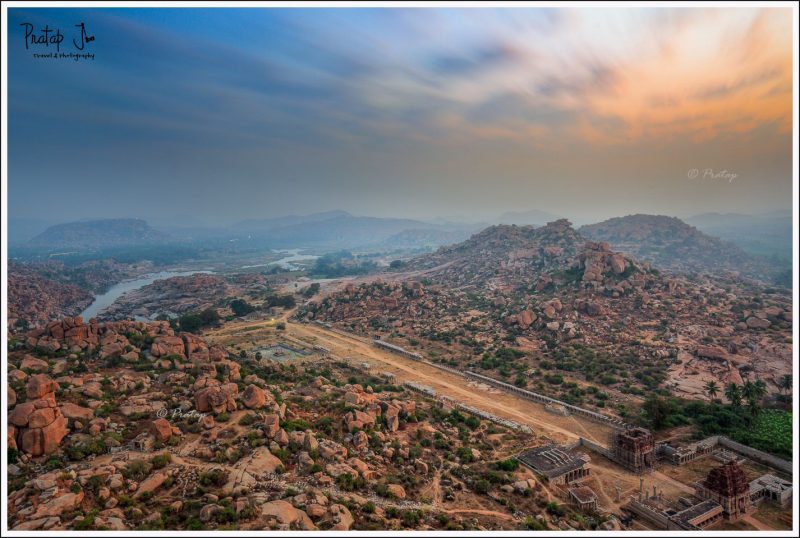
After getting our shots, we returned to the car by 9 am. Our next stop was Vitalla Temple. The plan was to scout the area in and around Vitalla temple, and pick spots to shoot the sunset later in the evening.
By the time we got to Vitalla, the harsh sunlight not conducive for photography. Being a Saturday, the place was heavily crowded. Private vehicles are not allowed in the last 1 km, and tourists have an option of taking an electric vehicle till the Vitatlla temple. We chose to walk.
Once inside, we were surrounded by tourists. A stone chariot, the icon of Karnataka Tourism Department, is in this temple. Most of the Krishna temple is in ruins, so composing an interesting frame is really difficult. I was put off by the heat and the crowd, and walked outside to explore the area around the main temple complex.
I discovered that there exists a direct path from Virupaksha to Vitalla temple. This route is beside the river, and a ten minute walk puts you near Mathanga. In contrast, the walk from Vitalla temple to the parking lot takes longer. And from there, Virupaksha temple is 8 km by road. A lot of interesting ruins are on the route connecting Virupaksha and Vitalla. I noticed giant entrance-ways, ruined temples, and the Purandaradasa Mandapam by the river side. I made up my mind to visit these places during twilight to make my pictures.
It was around 10.30 by now, and we were hungry and tired. An old couple were preparing traditional breakfast of Mandakki OggaraNe (puffed rice poha) and bajji near the river. This was it! We relished the food which we so unexpectedly found, and when we were so hungry. A sugarcane vendor nearby provided much needed refreshment.
We returned to the room via boat to take rest before the second half of the shoot. At about 3.30, we were back in Hampi. With the car parked on the Hampi side, we did not have any curfew in the evening. I intended to cover the route from Virupaksha to Vitalla by foot, concluding the day at Vitalla temple at sunset.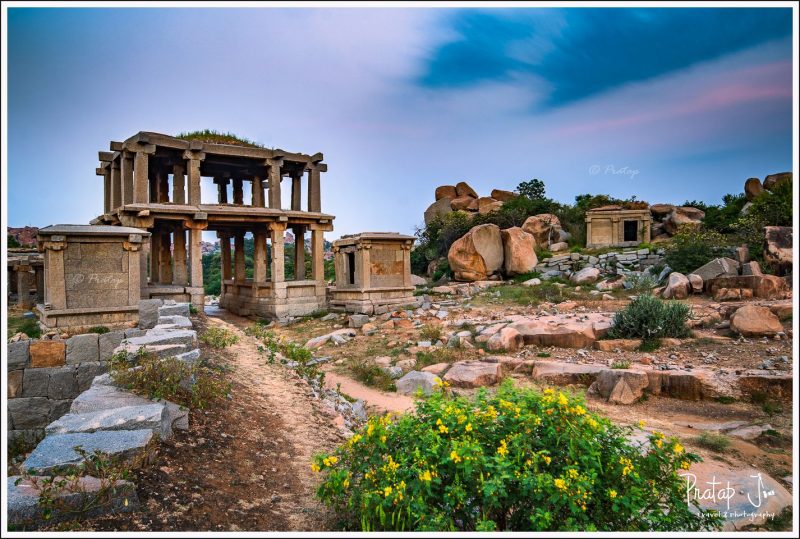
A left turn before Mathanga when walking from Virupaksha puts you on the route to Vitalla. You walk past huge boulders, and small caves, before reaching the river banks. I was anticipating interesting activity near the river, but didn’t find anything worth photographing. Coracles from here take you to the smaller ruins near the banks of the river on the other side. Notable is an island that houses a 1000 tiny shiva linga(s)
As we continued the walk, we came across the temple dedicated to Kodandarama. Behind this river facing temple is an area known as the Courtesan’s Street. A pushkarni here looked beautiful with the still water reflecting the surrounding terrain. I decided to make this my first halt. Beyond the pushkarni is the Achutaraya temple. If you are interested in shooting birds, the area near the pushkarni has plenty of king fishers and bee eaters.
As we walked towards Vitalla, we first saw the Varaha Temple. The path then lead us to the ruins of the Narasimha temple, which is also river facing. Walking, I imagined how it would have been during the days of the king. The courtesan’s street was apparently once a thriving market that sold precious stones by the kg. Intriguing as it is, the courtesan’s street and the temples of the area were right beside each other. I couldn’t fully explore the river side ruins, and hope to do so more diligently in future. For now, it was a rush to get to Vitalla temple before they closed at 6.
For all the meticulous planning, Vitalla temple was a huge disappointment. There were too many people everywhere. When we set up our tripods, the crowds found us more interesting than the ruins. The monuments officially close by 6 pm, so we were hoping the tourists would vacate a little before that. Unluckily for us, every tourist until the last one mindlessly walked into our frame. Tourists generally like taking photos of themselves in front of the artifacts so there was no point aiming the camera towards the ruins.
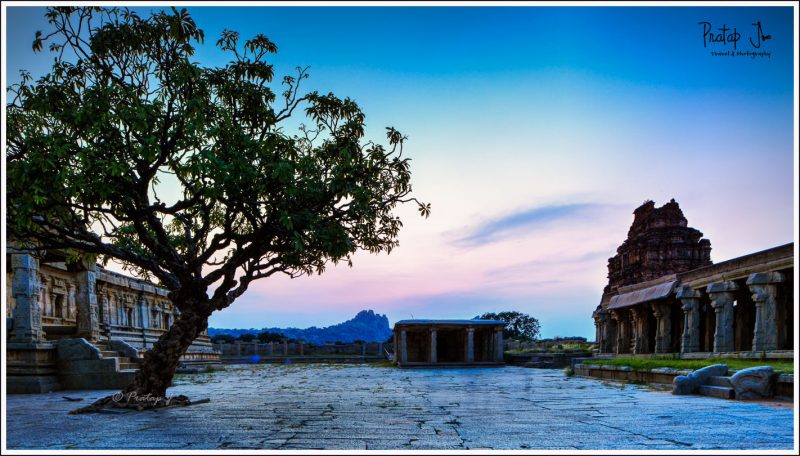 We stayed a little beyond 6, until the annoyed guards literally kicked us out. They did not understand what we were shooting in the dark. The tripods that we carried only served as an excuse to police us – and the reason we had it was totally lost on them. The face-palm moment was when one of the guards, wanting to convey his interest in photography, took out his mobile and showed a photo of him posing on a bike. Vijayanagar, its glory, and the fact that we were photographing a Unesco World Heritage site almost came to naught.
We stayed a little beyond 6, until the annoyed guards literally kicked us out. They did not understand what we were shooting in the dark. The tripods that we carried only served as an excuse to police us – and the reason we had it was totally lost on them. The face-palm moment was when one of the guards, wanting to convey his interest in photography, took out his mobile and showed a photo of him posing on a bike. Vijayanagar, its glory, and the fact that we were photographing a Unesco World Heritage site almost came to naught.
Once outside Vitalla, there was nobody to stop us. That is when I shot this.
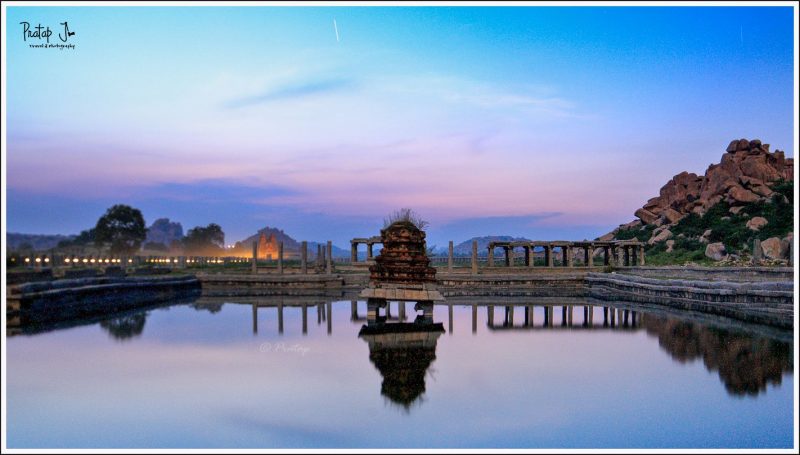
Reflections
With each visit to Hampi, I find the reference to Hampi as a ‘tourist’ destination shallow, and inaccurate. Hampi is an experience by itself, and a rare glimpse into the wonderous accomplishments of our ancestors. Hampi sees a lot of visitors from far and wide. On my most recent trip, I saw international tourists, buses with aged people from Rajasthan, families mostly from Karnataka, and youngsters from cities like Bangalore and Bombay.
Baring for a few foreigners who actually looked interested in the ruins of the Vijayanagar Empire, the others had agendas that seemed far removed from the essence of Hampi. The young crowds at Anjanadri where we stayed were quite involved in merry making with the choicest of intoxicants. Families with kids looked most delighted while eating and littering around the protected monuments. And I had no clue why senior citizens from Rajasthan were camping around Hampi (or why they chose to crap in the open instead of the nicely constructed public toilets).
All in all, Hampi seemed more like an excuse for people to go somewhere and do something. Is this how it should be? Can it be any different? I think Hampi has a lot to offer in terms of history, heritage, and experience. Hampi is more than a tourist destination – it is the story of a legacy which a developing country like India needs to know about. If nothing, visitors to Hampi should at least be enlightened about the glory of our ancestors – hopefully inspiring them to take the motherland seriously. I am not saying that visitors to Hampi should all have only one take-away. I have a problem with the fact that the heritage aspect of the aspect is totally overshadowed everything else.
The amount of bureaucracy you see is also staggering. The lady whom I interacted with at the ASI office for permission to use the tripod told me that Hampi will have its own Circle Office starting October. We were in the last week of September, and she wasn’t sure if the permission would come through from the Bangalore office. Nevertheless I submitted the letter, and followed up a week later. As expected, the Bangalore office washed their hands off and said they have stopped issuing permits. Determined to get what I wanted, I called up the Hampi office. The guy at the end of the line was clueless about the procedure, and asked me to contact the deputy officer. Luckily for me, he gave me the deputy officer’s mobile number. After bugging the officer a couple of times, I managed to get his attention. He finally conceded to my request and asked me to meet him in his office in Kamalapura after arriving in Hampi. Kamalapura is a town next to Hampi, and houses the ASI museum and office. This is what it means to be a photographer in India. You have to deal with an inefficient system even when your intention is to capture the beauty of the country’s own heritage.
If you wish to experience Hampi, check out these fixed itineraries from HikerWolf.

